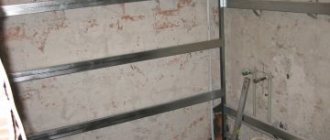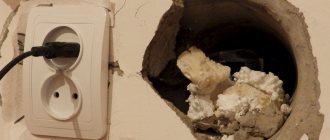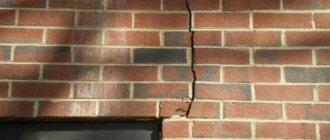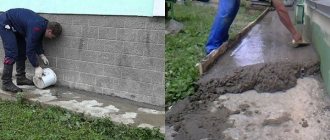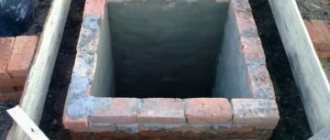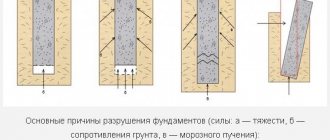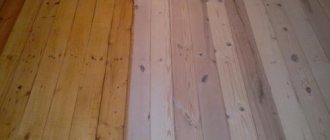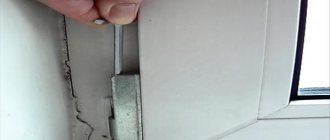Concrete coatings are used in a variety of areas: when installing floors, concreting surfaces in both industrial and residential buildings, constructing highways and much more. However, concrete has a low tensile strength, so during the hardening process the mixture contracts slightly and shrinkage of the structures occurs. Because of this, minor and more serious defects appear on the surface. In this case, sealing of cracks in concrete is required, which is performed using different technologies depending on the type of damage and the cause of its occurrence.
Epoxy resin
Repair compounds for sealing cracks in concrete based on epoxy resin are used to eliminate small cracks in a monolithic foundation; this mixture can also be used to repair the foundation in a private house.
Work to eliminate defects consists of three stages:
- Cleaning the area from small fractions.
- Drying the problem area.
- Filling the crack with epoxy resin.
Cleaning the problem area is done using a stiff metal brush. It is necessary to treat the inside and the surface around the crack. Removal of fine fractions and dust is carried out by blowing, after which you can dry the area with a construction hairdryer.
Before repairing cracks in concrete on the street using epoxy compounds, it is necessary to place special nozzles along the entire length of the problem area with a spacing of 30 cm. The installation of nozzles along the height of the wall begins from the lower section of the crack, 30 cm from the level of the blind area.
Epoxy adhesive is formed by mixing resin with a hardener. This mass is injected into the fracture through nozzles, starting from the bottom. The solution gains full strength within five days, after which the nozzles are removed (cut off), and the surface of the repaired area is rubbed using an epoxy solution.
Liquid glass
To eliminate small cracks in the screed, as well as to mask the seams between floor slabs, it is recommended to use a mixture for sealing cracks in concrete with the addition of liquid glass.
Prepare a special solution:
- liquid glass - in a volume of 20% of the total mass;
- cement - 20% of the total mass;
- sand - 60% of the total mass.
All ingredients are thoroughly mixed with the addition of water until the required consistency is formed. The mixture should be quite thick and viscous.
Sealants
Almost any size crack can be effectively repaired using concrete crack sealant. The elastic material tightly seals the defect, expanding in volume.
The preparation process also involves cleaning the problem area from large and small fractions, but before using the sealant, it is necessary to moisten the base and cut small grooves for better adhesion of the sealant to the concrete.
Silicone sealant.
Crack tolerances
Acceptable parameters regarding defects in concrete are regulated by SNiP 52-01-2003. Here are the basic standards for crack width:
- up to 0.3 mm with prolonged opening, up to 0.4 mm with short opening (condition for preserving the reinforcement in the structure);
- up to 0.2 mm with prolonged opening, up to 0.3 mm with short opening (to maintain optimal permeability of concrete);
- up to 0.5 mm (during the construction of hydraulic structures);
- up to 0.3 mm (if the structure is located in an aggressive environment);
- up to 0.3 mm (in the case where the structure is reinforced with reinforcing rods susceptible to corrosion).
Permissible crack opening width
Self-expanding cords
This method is used to carry out repair work in the bowls of outdoor swimming pools, to restore monolithic foundations and restore the integrity of external walls in industrial premises.
To carry out the work, you will need to prepare the area by clearing it of small fractions and dust, measure the depth and width of the crack and select a suitable self-expanding cord or tape.
A cord is placed into the pre-prepared seam and the remaining space is filled with polyurethane sealant from a mounting gun. Excess sealant is leveled with a spatula, and after the material has risen, the surface of the problem area is sanded.
This method of eliminating defects in concrete surfaces allows you to select a cord to seal any crack, which ensures complete sealing of the seam and a long service life. An important feature of the method is the ability to perform work at subzero temperatures.
Main causes of defects
Despite its high strength characteristics, any concrete structure is susceptible to destruction. The main factors that contribute to this:
- Temperature changes. If the poured surface is not protected with frost-resistant mortar or insulation material, then constant temperature changes will negatively affect the concrete composition.
- As a result of frequent cycles of freezing and thawing, moisture enters the voids in the material. At negative temperatures, it expands, as a result of which it begins to destroy the concrete product from the inside. Cracks of different sizes gradually spread throughout the material, as a result of which the strength of the concrete decreases significantly.
- Carbonization of the material also leads to the appearance of various defects. The material begins to absorb carbon dioxide, which does not affect the strength of the structure of the concrete product, but contributes to the destruction of the reinforcement. It is part of many concrete structures. Saturation of cement with this gas leads to the formation of lime, which creates an alkaline environment in the material, leading to corrosion of steel reinforcement. It increases the volume of the latter and increases internal tension. The result is the appearance of cracks in the material and exposure of the reinforcement, which gradually rusts.
- Exposure to sulfates (salts of sulfuric acid) leads to the gradual appearance of cracks and destruction of materials. These substances react with other chemical elements, resulting in the formation of chalk and other components. All of them lead to the fact that the concrete begins to increase in size. The result is the appearance of faults and destruction of the product.
- Table salt also leads to the expansion of concrete, the appearance of cracks and further destruction of the structure. Deformations that have arisen due to this substance can be distinguished by standard white smudges. Further destruction can be prevented by treating the material with hydrophobic compounds or polymer impregnations.
The appearance of cracks on a concrete surface can be associated not only with the influence of external factors, but also with non-compliance with the technology of pouring the structure. The reasons in this case are the following:
- During the preparation of the working composition, more water was taken than required. Excessive amounts of moisture negatively affect the strength of the concrete surface.
- At the stage of pouring the structure or structure, a low-quality composition was used. It is possible that cement of poor quality was purchased to prepare the composition, or the required part of this component was incorrectly adjusted.
- Concrete gains strength only in a moist environment, so we should not forget about the need to retain moisture in the freshly laid material. It will take approximately 28 days to reach the required strength. After the working mixture is poured, it needs to be irrigated with water for the first 3 days. It is also important to thoroughly compact the solution when pouring it into the formwork - this will reduce the porosity of the concrete and give the structure uniformity.
Sealing methods
The following methods are used to repair cracks in concrete:
- injection by supplying a solution using special mechanisms into the depth of the crack;
- the use of special solutions based on CPS with polymer additives, followed by treatment of the repaired surface with polyurethane sealants;
- shotcrete using special mixtures based on CPS with bitumen additives.
The most effective way to fix the problem is injection. This method involves preliminary drilling of deep holes, which are directed at an angle to the problem area.
Injection stages.
Using special devices, a solution based on synthetic resins is pumped into these holes, which, when strengthened, allows you to eliminate defects and significantly extend the service life of the structure.
To combat small cracks (up to 4 mm) on personal objects (dacha, apartment, balcony), repair mixtures based on DSP and epoxy glue are used. When the solution is prepared correctly, it sets quickly, as a result of which the defect is eliminated.
Placement of packers during injection.
To strengthen a structure in which a crack more than 4 mm wide is found, the use of a solution based on liquid glass is required, for which one part of cement, three parts of water and sand, and one part of liquid glass are mixed.
Types of cracks and the cause of their appearance
All cracks can be grouped due to their formation in the structure:
- through - formed due to high axial tensile loads;
- force (shear cracks) - the prerequisite is the influence of transverse force, such defects pass at an angle to the reinforcing elements;
- hair - appear due to temperature changes;
- parallel - they pass next to the reinforcement, the reason for the formation is incorrect anchoring, rapid settlement of the building, swelling of the soil;
- cracks in the stretched zone - appear when bending, directed at right angles to the reinforcement;
- technological - associated with a sharp temperature jump on the surface of concrete.
Shrinkage cracks
As the amount of moisture in concrete decreases during drying, the volume of the material decreases. In the surface layer, where the solidifying solution is less dense, tensile stress arises. Typically, shrinkage cracks are hairline cracks and do not affect the load-bearing capacity of buildings, but can reduce the service life of the entire structure. Despite their small width, air and liquids still penetrate through them, which over time causes the metal rods to rust. Rust gradually leads to the growth of cracks, and freezing moisture completely breaks the upper layers of concrete. As a result, repair work has to be carried out.
Shrinkage cracks in the foundation
Temperature cracks
Such defects can exist in two forms:
- Reason: non-compliance with the warm-up regime during winter work. If the temperature difference is higher than 20-50 degrees, and the rate of heating and cooling is more than 5-15 degrees per hour, the appearance of such cracks is highly likely. Novices usually violate the recommended conditions for pouring the solution, and such a mistake is made quite often.
- Reason: hydration heating. If this happens during concrete curing in large structures, thermal deformations appear in the form of a network of defects.
Failure to comply with temperature conditions when pouring the foundation
Cracks during manufacturing, transportation, storage and installation
If the standards for transportation and storage of concrete products are not observed, loads often arise that are excessive. An example is the installation of pads under slabs at a great distance from the ends, which provokes a high bending load. The upper part of the product stretches because the number of reinforcing rods there is reduced.
Transportation of concrete slabs
The result is the formation of cracks, and they can appear not only at the top edge, but throughout the entire slab with its subsequent destruction. In any case, the strength of such a product will decrease. Prestressed structures especially often deteriorate from loads. Another example of cracks occurring is when pads are placed offset rather than underneath each other. In such a situation, the bottom plates crack and cannot withstand the stress.
What is better to use
The type of repair composition depends on the location of the defective surface (vertical or horizontal), the purpose of the room and the operating conditions of the concrete surfaces, as well as the time of year in which repairs need to be carried out.
Almost any solution is suitable for repairing horizontal screeds, but only viscous and thick solutions or self-expanding cords are suitable for fixing a problem on a vertical wall. If it is planned to restore the concrete base in rooms with high loads (boxes for trucks), compositions with high strength characteristics will be required.
The information on the packaging of the finished repair mixture will help you avoid problems.
Work technology
Before repairing cracks in concrete, you should prepare:
- heavy hammer;
- bit;
- hard brush with metal bristles;
- putty knife;
- brush;
- grater;
- trowel;
- pieces of reinforcement up to 10 cm long.
Work order:
- At the first stage, it is necessary to carefully check the damaged area and eliminate any emerging chips using a chisel and hammer. The area where the chip was removed is trimmed, the crack is roughly processed along its entire length, expanding it slightly.
- Small and large fractions of concrete are removed from the crack using a coarse brush, then cleaned of dust using a vacuum cleaner. Using a spatula, an additional deepening of the seam is made to prepare the surface for the repair mortar to firmly set.
- If the width of the crack exceeds 4 mm, it is recommended to use local reinforcement, for which, using a grinder, transverse overlapping grooves are sawed to a length of up to 10 cm, into which pieces of reinforcement with a thickness of 4 mm or more are placed. In the same way, through cracks in the base of the floor or ceiling slabs are prepared for repair.
- If, when preparing a problem area, reinforcement exposed on the surface is found, it is necessary to clean the metal parts using sanding paper and then treat it with a solution that protects the metal from rusting.
- Before applying the repair composition, the surface is treated with a primer.
- The next step is to prepare the repair solution. Expanding cement is more often used to seal cracks made of CFRP with a liquid glass additive. This mixture is applied to the area and moistened. When filling deep cracks, it will be necessary to apply the solution several times, waiting for each previous layer to rise.
- After the repair composition has dried, the joint is grouted, leveling the surface of the problem area.
- Filling of cracks in horizontal surfaces is carried out with the level of the repair mortar exceeding the level of the screed, since the mixture shrinks when standing up. Excess solution is removed with a grinding machine.
Work on the repaired surface (laying roofing material on the roof, laying the finishing coating on the self-leveling floor, facing the outer wall with brick) is carried out no earlier than 72 hours later.
Classification of concrete damage
As a result of various internal and external influences (see Table 1), concrete can crack. This applies to large and small objects stressed by external loads or under tension from their own weight. To understand why concrete cracks after pouring, you first need to know the classification of cracks.
Spalling and cracks in concrete vary:
- by nature – through and superficial (deep and shallow). To determine the depth, various types of probes and ultrasonic devices are used;
- in width – microscopic (hair-like), medium (over 1 mm), wide, massive (more than 10 mm). To determine the width of cracks, measuring instruments of varying accuracy and nature are used;
- by exposure of reinforcing elements - promoting corrosion (up to the reinforcement, with its complete or partial exposure) and passing between the reinforcement elements (along the edges, in the spaces);
- by time of formation - primary (during the process of hydration, shrinkage of the concrete mixture) and secondary (during the operation of the structure);
- by location - at the corners and edges of a concrete object, over the entire surface, throughout the entire volume, local (for example, in the area of applied stress or periodic mechanical influences);
- according to the degree of impact on the structure - reducing strength (5...50%), destroying (reduction in strength over 50%).
Important: if the expected concreting and operating conditions are violated, the occurrence of cracks is inevitable, therefore a margin of 10...30% is included in the design conditions.
